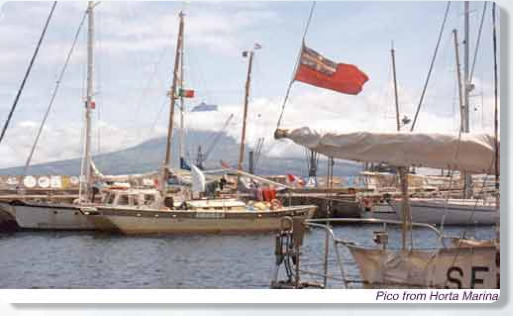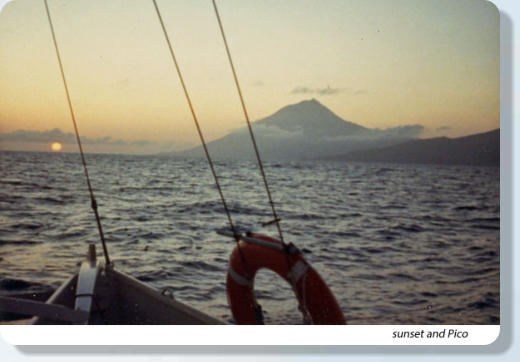Chapter 7 — The Azores
The next morning the winds were favourable and we set out on the one hundred and fifty mile run to the port of Horta on the island of Faial. It took about three hours to work our way out of the lee of Flores, but then we tramped along in fine style. By the following morning we were coasting along the north side of Faial, admiring the incredibly green terraced fields and the tiny whitewashed villages with red roofs [it is in one of those villages that we now live]. Ahead the 7,000 foot volcano Pico on the next island emerged from its usual cloak of cloud, and at four in the afternoon we rounded Ponta Ribeirinha, the north east corner of Faial, and headed down to Horta. The new marina at Horta has been open for three years now and all visiting yachts must stay there. At six o'clock we tied up at the convenient administration dock where customs, police and port captain (all the officials with whom it is necessary to clear) are side by side and open twelve hours a day, seven days a week. Total entry fees came to less than a dollar. The marina itself is excellent with good modern floating docks, fresh water (during business hours), electricity (220V), showers and a laundromat and all for 400 escudos a day; less than three dollars! Ashore our first visit was to the Café Sport to check for mail. I am afraid the days are gone when, with two or three yachts in port, Peter Azevedo would personally take visitors in hand and show them around town. Today the Café Sport is almost always full, with the overflow sitting with their drinks on the seawall outside. Peter continues to hold mail for yachts though, and forwards it promptly when they move on. He also offers currency exchange at the same rate as the banks, but with no paperwork or other formalities and open at all hours. Before I left I gave him a TMCC burgee to pin to the wall among hundreds of others from all over the world, and by chance he put it next to an Aquatic Park Sailing Club [Toronto] burgee presented by the yacht Xanth. I had last seen them in Beaufort, North Carolina almost a year earlier. Our visit to Horta coincided with Sea Week, an annual festival held between the first two Sundays in August. Ashore there are cultural events, parades, bands, folk songs and dancing, while afloat there are races for the visiting yachts and local boats. All visiting crews were invited to a wine and cheese party at the Horta Yacht Club to fill out entry forms. There were to be separate classes for mono- and multihulls, but within the classes the only criteria would be waterline length. This meant we would be racing on equal terms with a big Newick tri Olympus, and would have to give time to a particularly wicked looking Derek Kelsall C-STAR racer Gazelle (there were a number of returning C-STAR boats in port). Oh what the heck; we were entering for the fun of the thing weren't we. The first race on Tuesday was a short round the buoys course, and we did badly, getting caught in a strong adverse tide instead of following those with local knowledge who hugged the shore. There was a single handed race on Wednesday; ten miles to Madeleina on the island of Pico and back. Close hauled one way and broad reaching the other. Oborea was fifth over the finish line and third multihull. Thursday was the Rallye da Sereias or ladies race. The original rules called for all female crews, but as there were no entries, it was opened to boats in which the majority of the crew were female. Either way we were out of it, but I did notice Olympus at the start with ten bathing belles draped around the deck! This trimaran has an interesting history. Originally Mike Birch's Olympus Photo she was lost at sea and cut in half by a freighter. Half the remains drifted near the Azores where a local enthusiast salvaged her and, without plans, built another half to match the one he had found. Today she looks as if she has just come from the boat show. Incidentally in Portuguese her name is pronounced "Olympush". My crew had to fly back to Canada before the big final race so I had to recruit a Portuguese crew, four university students. There were two girls, one of whom spoke some English and both named Isabel, and two boys, one of whom spoke French. Communication was a bigger problem than sailing! We got a good start, but split a seam in the genoa in a squall. Our sail change was very slow and we lost a lot of time, but by the end of the race we had worked our way back to the middle of the pack and had a lot of fun. Sunday night there was a dinner for all competitors at a fancy hotel, and all those who did not receive trophies (beautiful glass whales on wooden bases) got a bag of Azores souvenirs—everything from neck ties to cigars. No racing fees or charges for anything, the whole bill was picked up by the tourist bureau. This is certainly the friendliest place I have visited, but unfortunately this will probably change as their tourist promotion starts to work and visitors become more common. In fact people who have visited before already notice a change—hurry before it is too late. Horta is a neat little town with cobbled streets and mosaic sidewalks. Almost everything is available in the stores and local fish and vegetables are unbelievably cheap. Even imported goods in the supermarkets are no more expensive than in the USA. There are some beautiful walks through winding country lanes bordered by blue flowering hydrangeas. Farmers on donkeys pass with a cheerful "bom dia". On one of my walks I climbed 3,000 feet to the mile wide volcanic crater or caldera in the middle of the island. I spent over two weeks in Horta (my marina bill came to fifty one US dollars!) before sailing a hundred and fifty miles east to Ponta Delgada on the island of São Miguel. This is the biggest of the few all weather harbours in the Azores and is also the commercial centre and the largest city. Heavy traffic in the harbour, but they still set aside ten moorings for visiting yachts at no cost. There is a bigger selection in the stores than in Horta and a huge farmers market. My last stop in the Azores was at Vila do Porto on the small island of Santa Maria, fifty miles south of São Miguel. They have recently built a new longer breakwater to protect the harbour, but they have not changed the alignment of the leading lights. If you follow them in at night you will pile up on the breakwater ten feet from the end! There was one other yacht in the little harbour (which is wide open to the south east) a Belgian catamaran. The town is on a high fortified bluff overlooking the harbour which gives a wonderful view out to sea, but it is quite a climb from the harbour for the morning bread and milk. There used to be a large U.S.A.F. base on the island, but it is now gone and a lot of the local people have gone too, leaving this one of the more depressed islands. Like all the islands though, the scenery is magnificent and it was with some sadness that on August the twenty fifth I finally left the Azores, the hospitable islands, for the eight hundred mile crossing to the Portuguese mainland.
